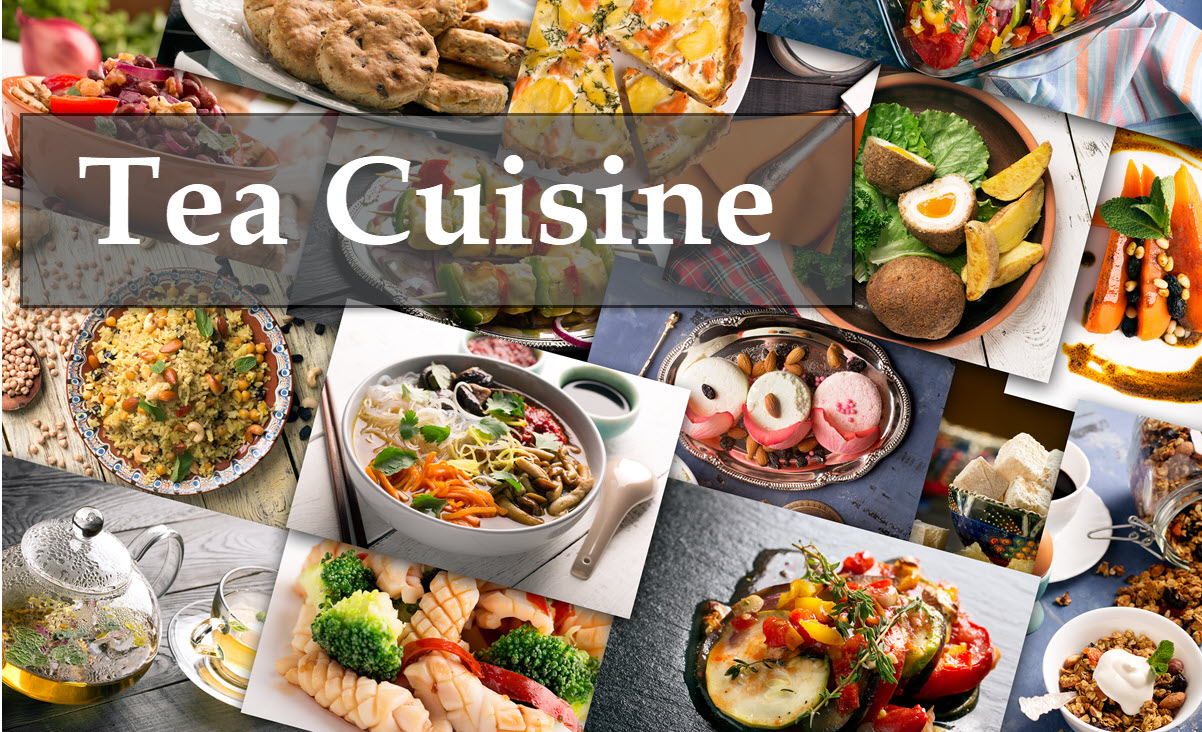
Tea as an Ingredient is Now Mainstream Globally
Something began brewing in chef’s kitchens in the late ’90s.
Chef Robert Wemischner was preparing his book, Cooking with Tea, Cynthia Gold was experimenting with tea in recipes at her cafe in Cambridge, Mass., and Ravi Kroesen was beginning a job search that would lead to his work in a tea warehouse in 2000. At the time, the West was discovering the many uses of tea in cooking, techniques known in the East for centuries — and was inventing some new uses of its own from matcha shortbread to mixed drinks..
Today, Cooking with Tea (2000) is considered a classic, as is Gold’s book with Lisë Stern, Culinary Tea (2010). Kroesen is vice president at Portland’s Smith Teamaker, home of the Tea Cafe, where tea can be found everywhere on the menu.
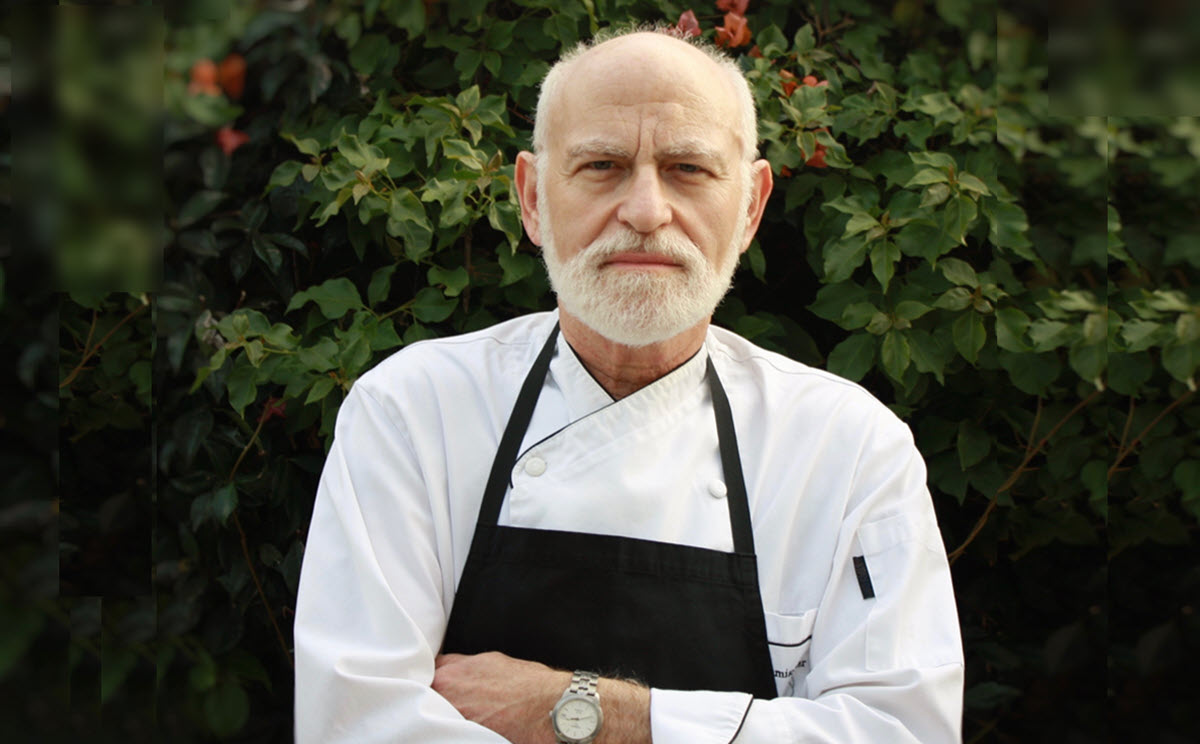
Robert Wemischner — Tinkering with Tea
As a young student at the University of Pennsylvania, Robert Wemischner was studying Asian languages and, through that study, was introduced to green tea, which he began drinking daily. His palate broadened to include Chinese black teas. “Green tea may not be the easiest flavor profile to introduce people to,” he said. But it set him on a journey that resulted in a first book, 1994’s Vivid Flavors, in which he describes himself as “tinkering with tea as an ingredient.”
His curiosity about this led him to delve deeper into the many world teas and the subtleties of their flavors, “refining my palate and learning how to pair them with food,” he said. He trained as a pastry chef and was deeply influenced by the work of the late Devan Shah, “who pioneered high-quality specialty teas.”
He kept tasting and experimenting with tea as rubs, marinades, poaching liquids, and as a way to smoke food. “As a pastry chef, I learned that the flavor of tea is carried by the fats, the butter, and cream,” he said.
Then came Cooking with Tea. Co-authored with Diana Rosen, the book contains 100 recipes for everything from Duck Foie Gras with Tea-Poached Apricots to Waldorf Salad with Mango Scented Keemun. Also covered are tea history and types, how to brew tea for use in cooking, and techniques for cooking with tea.
Decades later, he’s still cooking with tea, posting regularly on the “T-Ching” blog, which he describes as having “built a community” of people who enjoy cooking with tea. Two recent posts are “Tea-smoked Chicken” (“Great for summer, as a picnic item, a sandwich with tea mayonnaise, or a chicken salad. You need a wok.”), and “Tea-poached Peaches a la Mode,” another perfect summer dish.
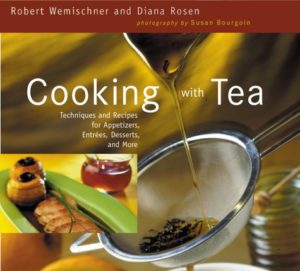 Wemischner is a frequent presenter at the Los Angeles Tea Festival, which returns this year in August, where he often showcases sauces, dipping syrups, and tea pairings with cheese and chocolate.
Wemischner is a frequent presenter at the Los Angeles Tea Festival, which returns this year in August, where he often showcases sauces, dipping syrups, and tea pairings with cheese and chocolate.
Wemischner offers this advice for anyone beginning to cook with tea: “First, understand tea as a beverage. Learn how to best capture the flavors. Buy from reputable sources, in small amounts at first, and taste multiple teas in the same category. Then, consider the cooking method, which may either concentrate or dilute the flavor.”
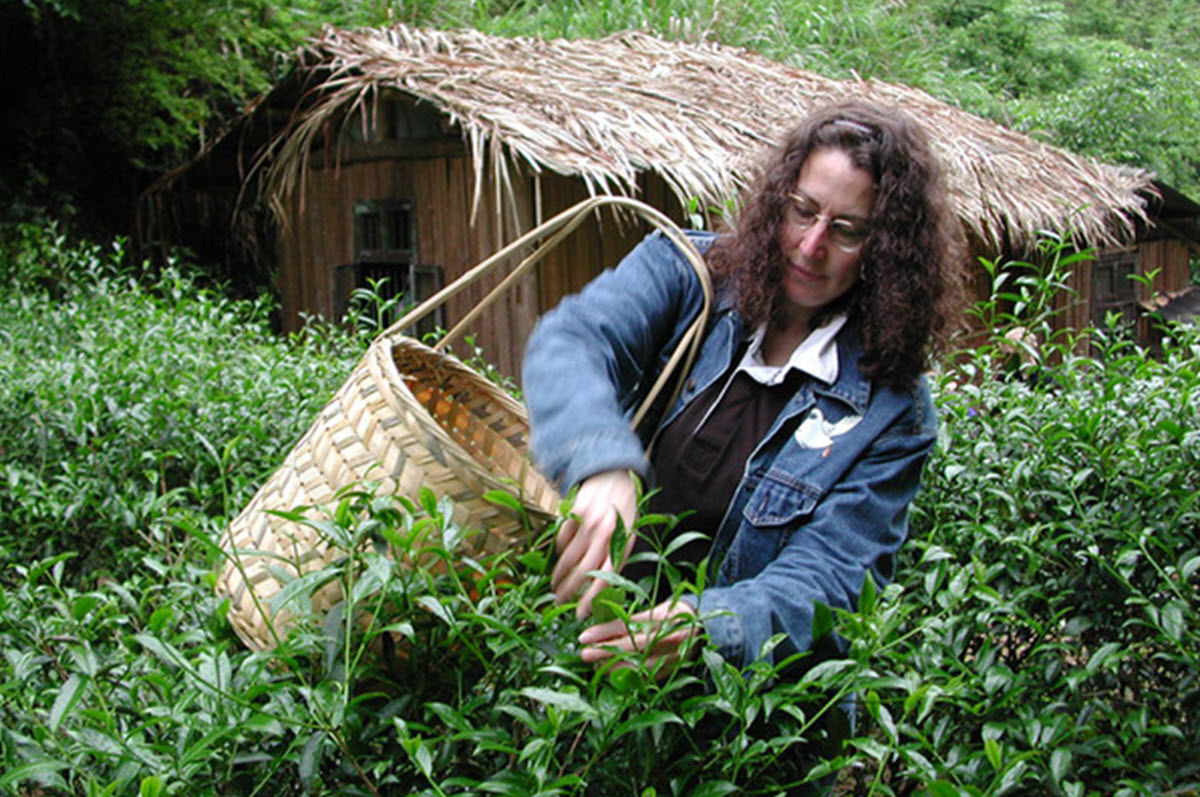
Cynthia Gold — Leaves of Tea
Cynthia Gold had been a pastry chef at several Boston-area restaurants before opening her cafe. To complement her focus on desserts, she was advised by a friend to serve teas, differentiating her offerings from the many coffee shops.
“We decided that it would be fun to set ourselves apart with an extensive tea menu. I think the first menu had 40 teas listed, and the numbers kept growing,” Gold said. Being surrounded by tea leaves inspired her to play with the tea “because interesting, available ingredients would tempt any chef.” Her partner in the first venture, Mark Yedvabny, contributed a tea-cured gravlax recipe. Gold’s first tea-inspired dessert was a fruit tart with green tea-and-jasmine-scented pastry cream, leading to more recipes.
She opened a second restaurant with a more serious menu and an extensive tea list that continued to inspire the cuisine. “Because it was very unusual at the time, I was fortunate that there was quite a bit of press about what I was doing. Over time, instead of articles about my techniques and recipes, I was asked to begin writing the articles myself,” she said.
She discovered she enjoyed writing about cooking with tea and doing it. She began building a recipe database and continued writing and teaching about cooking with tea. “As I taught on the subject at culinary and tea conferences and culinary schools, I was always asked if any good references were available. I finally decided to write one myself,” she said. Her co-author, Lisë Stern, was a food writer she’d met the first time Stern wrote about her and her work.
“[Stern] later wrote an article on masala chai, tasting commercial and handmade examples from across New England, and selected my handmade masala chai as the best,” said Gold. “It was a fun honor, but more importantly, it led to an ongoing friendship, so when I had a rough book draft, I reached out to her to help me turn it into a final manuscript.”
Culinary Tea features more than 100 recipes, including classics such as the centuries-old Chinese Tea-Smoked Duck and Thousand-Year-Old Eggs and recipes the authors developed and collected, such as Smoked Tea-Brined Capon and Assam Shortbread. The book delves into the basic techniques of cooking with tea. One of Gold’s favorite recipes from Culinary Tea is “Pu-Erh Clay-Cooked Chicken,” and, she said, “My husband always loved the “Spiced Pork Tenderloin with Mango and Peach Chutney.”
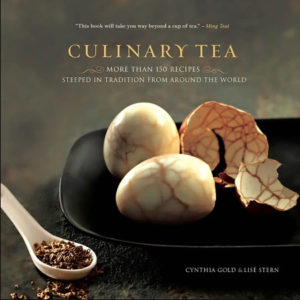
She feels that Culinary Tea’s least-finished chapter is the one on cocktails. “Although it gives a nice foundation to get someone started, all my favorites were created after the book came out. My two favorite cocktails, the ‘Southern Earl Grey’ and the ‘Green Tea Gimlet’ have both been featured in Tea Journey.”
Another popular recipe Gold contributed to Tea Journey is a classic Southern Chess Pie variation. “Sweet tea is so ubiquitous in the South that it made complete sense to make its way into uniquely Southern desserts,” said Gold. Yet another recipe for “Tea Ghee” came about as she infused tea into different liquids and then used them in various recipes. “Infusing butter with tea to use in its melted state, or chilled down and used in baked goods was just a natural extension of that,” she said.

Ravi Kroesen — Have Tea, Will Travel
Ravi Kroesen is now an executive at one of the West Coast’s best-known tea vendors, Portland’s Smith Teamaker. But in 2000, when he took a job in a tea warehouse, he began drinking tea every day for the first time in his life. He sampled a Chinese oolong, savoring its notes of fresh peaches and orchids.
“My life changed with that sip,” he said. He began reading voraciously about tea. He moved to New York, beginning a career in tea and working at jobs that “rounded out his perspective” on the industry. He has been with Smith Teamaker since 2018. He recalled his first experiences with tea as a culinary ingredient.
“In 2014, I went to China and tasted a dish made using smoked black tea,” he said. The experience opened a new perspective. And now, as head teamaker, he can use that perspective at Smith’s Tea Cafe.
The cafe opened in 2021 but was conceived in 2019 with chef Karl Holl. The Smith Teamaker website states: “Karl worked hand-in-hand with our tea department to innovate new ways to weave tea and food together for an exceptional flavor experience…Beets for the Garden Sandwich are roasted in fragrant jasmine tea…and floral White Petal tea infuses the sheep’s milk cheese on the Rainbow Carrot & Barley Salad. At breakfast, house-made Chocolate Hazelnut Granola is doused with Chai Milk (hot or cold). Coconut yogurt is topped with a house-made Red Nectar Strawberry Jam (strawberry jam infused with Red Nectar, our rooibos/honeybush tea blend).”
Every food item on its menu features tea as an ingredient, and there is constant experimentation, Kroesen said.
The menu is seasonal, so, for example, the Winter menu paired a “Forager Noodle Bowl,” soba noodles in a broth made with smoked black tea, kombucha made by a local kombucha maker, Camellia Grove. On the Spring menu is the “Smith Bowl” (Sencha-infused quinoa, kale, apple, tea-plumped raisins, roasted sweet potato, chai-spiced walnuts, cider vinaigrette), “which pairs excellently with our Phoenix oolong,” Kroesen noted.
Regular training is needed to educate the staff on how dishes are prepared, as Portland’s customers often ask questions about the teas used. And tea pairings with dishes are still evolving.
“This is a life dedicated to the craft,” said Kroesen.
The future of cooking with tea
What’s next for chefs and home cooks, as the use of tea in recipes from sandwiches to haute cuisine continues to mainstream?
It’s worth noting, for instance, that well-known chain P.F. Chang’s Waikiki location now offers Oolong Chilean Sea Bass, a wild-caught tea-marinated filet served with ginger soy sauce and wok’d spinach.
“People are becoming more adventurous [in their tea drinking and food experiences],” said Kroesen. “It’s up to us to get that experience across to a wider audience.”
According to Cynthia Gold, “What’s changed is what I hoped would change. There is no such thing as ‘Tea Cuisine;’ it is no longer an oddity or a fad. It’s just another palate of ingredients and techniques that can and do inspire many chefs and mixologists.”
Tea as a mainstream recipe ingredient is firmly ensconced, she said. “Whether cooks are inspired to use it for health benefits, flavor profiles, aromatics, textures, a bridge between disparate ingredients, to complement other ingredients, to highlight or contrast with other ingredients, teas are incredibly versatile ingredients.”
Gold noted that cooking with tea is not about making something taste like tea. “In my mind,” she said, “the most successful uses of tea are when it has altered the end result in a positive way but is almost like the secret ingredient. It enhances without dominating for a well-balanced recipe, and since it can do that so well, I truly believe that tea in our food, cocktails and lives is here to stay.”
Editor’s note: Alongside the now-classic cookbooks already mentioned is Harney & Sons’ 2011 The Tea Cookbook. Created by Joanna Pruess and John Harvey, The Tea Cookbook is available on the Harney & Sons website. The book features dozens of easy-to-prepare dishes and lessons on all types of tea, including black, green, oolong, and herbal tea. John Harney lends his expertise on the correct way to brew tea, properly store tea, and the “seven cardinal sins” that result in inferior tasting tea for drinking or cooking.
Related
A Summer Barbeque by Cynthia Gold
Smoking Foods with Tea by Cynthia Gold
Is that Tea in your Cream, or Cream in your Tea? by Robert Wemischner
Q|A with Ravi Kroesen by Jessica Natale Woollard
Tea Market
Get More Value from Your Tea: BRU Maker One
+41794574278
Jacque's Organics
(647) 804-7263
What a joy it is to read this article! Cynthia really brings the point home by backing it up with solid, sensible and well researched information. Tea has found a permanent home in the world of cuisine, internationally.
Thank you Cynthia for bringing this giant step to my attention, really an exiting read!
Very interesting article, thank you! Culinary tea was one of the very books on tea I bought, way back when. My recent book about tea and food pairing, which also contains a chapter about tea as an ingredient, would have been a nice addition to this article. Especially since I focus in my book on more simple fare, for the home cook, with easy recipes, and with three matching teas to pair the dishes with. Might be interesting to feature next time? It is called: Tea, Wine’s Sober Sibling.
Thanks for this info, Mariella! And yes, we do cycle back around to topics, and I will keep your book in the file.
best wishes,
Janis Hashe
This does sound like a pleasant read.🍵
Hi Richard,
So glad you enjoyed the article, and Cynthia is indeed a wonderful source in the piece. Just wanted to point out that I (Janis Hashe) am actually the author. Best wishes!
Thank you Janis! Would you like me to send you the pdf?
I sent one to Dan, but I am not sure if you have access to it?
Best regards,
Mariella Erkens